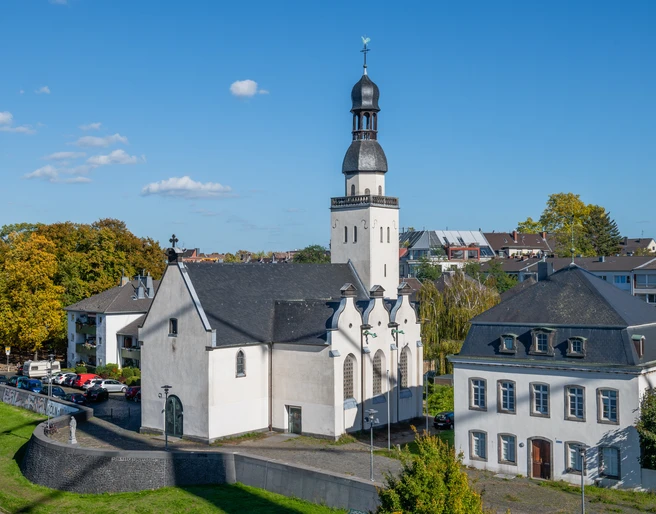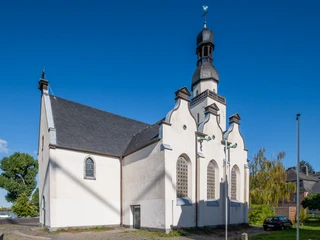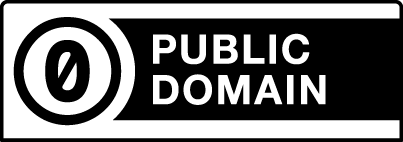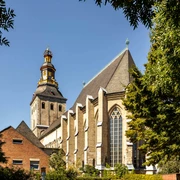- Photos & Map
How would you like to arrive?
- Website
- Description
- Good to know
- Nearby
Around 800 years ago, ships were made of wooden structures. Shoals, sandbanks, and whirlpools made navigation on the Rhine risky, and knowledge of the river's course relied on local traditions – in short, Father Rhine was a far more dangerous waterway to navigate than it is today. The existence of sailor churches like St. Clemens likely offered sailors a kind of spiritual anchor point where they could seek protection and blessings for their routes. This is certainly suggested by the direct location of St. Clemens right by the water.
Incidentally, Saint Clemens was often the patron saint of sailors and churches along the Rhine – thus St. Clemens is not the only church in Cologne dedicated to Saint Clemens. The Basilica of St. Kunibert also once bore his name.
Further extensions can be seen in a drawing from 1589 – here St. Clemens has a saddle roof with a pointed roof turret and possibly a porch. However, no traces of this late medieval period remain today.
The destruction of the fortifications in the fall of 1614 by the Spaniard Spinola also likely entailed the destruction of the church St. Clemens. Probably rebuilt or extensively restored, it was then three-naved in 1629. In 1720, the last expansion took place – until the ice flood of 1784, which destroyed a significant part of Mülheim and severely damaged St. Clemens as well. From 1796, St. Clemens then served as the parish church for Catholics in Mülheim.
After the war, reconstruction took place by architect Joachim Schürmann – in the years between 1952 and 1960. Schürmann wanted to create a whitewashed, simple church, where – as he put it – a "Romanization in the spirit of modernity" could be recognized. The bronze portal by Schürmann may particularly catch your eye on-site. Bellot, who attempted to reconstruct the construction history of the Clemens Church in 1994, criticized these works because the reconstruction did not reflect the pre-war state but rather represented a rationalized reinterpretation by the architect.
The route first leads over land – and stops at the Church of Our Lady in Regent Street, which was once built because the parish church St. Clemens became too small for the faithful, causing St. Clemens to lose parish rights in 1864. However, the starting point of the God Procession is the Church of Clemens – and St. Clemens is also the goal of the procession.
Incidentally, Saint Clemens was often the patron saint of sailors and churches along the Rhine – thus St. Clemens is not the only church in Cologne dedicated to Saint Clemens. The Basilica of St. Kunibert also once bore his name.
St. Clemens: small sailor church
The small, still the only Catholic church in Cologne-Mülheim from the 12th/13th century, where weddings, baptisms, and other religious activities actively take place, can be visited both inside and out. If you are interested in medieval sacred architecture, the numerous construction measures of the 16th, 17th, and 18th centuries that this place of worship has undergone are surely informative for you. Another special feature: St. Clemens is the starting and endpoint of an annual procession on Corpus Christi via land and on ship across the Rhine.Hall Church from the 12th/13th Century
The now three-nave St. Clemens was built around 1210 as a Romanesque hall church, single-naved, with a rectangular plan. However, this was only discovered in 1939 during restoration work: investigations revealed a concealed arch frieze and a pilaster division indicating a single-naved three-bay church that stood on the site by the beginning of the 13th century at the latest. In March 1949, the indications of its early origin as a Romanesque structure were confirmed. Although St. Clemens has Romanesque features, it is not counted among the 12 renowned Romanesque churches in Cologne, located on the other side of the Rhine in the city center.Conversions and Destruction: 15th, 16th, 17th, and 18th Century
The further history can be briefly described as follows: In 1414, the conversion from a chapel to a small church presumably took place. Linked to the expansion was a ducal endowment with the founding of a hospital and a vicarage. From then on, a priest was on-site to serve the community.Further extensions can be seen in a drawing from 1589 – here St. Clemens has a saddle roof with a pointed roof turret and possibly a porch. However, no traces of this late medieval period remain today.
The destruction of the fortifications in the fall of 1614 by the Spaniard Spinola also likely entailed the destruction of the church St. Clemens. Probably rebuilt or extensively restored, it was then three-naved in 1629. In 1720, the last expansion took place – until the ice flood of 1784, which destroyed a significant part of Mülheim and severely damaged St. Clemens as well. From 1796, St. Clemens then served as the parish church for Catholics in Mülheim.
Rebuilding by Joachim Schürmann
Only World War II again brought the necessity to do more than mere maintenance. After the bombings by the Allies, only remnants of St. Clemens remained, consisting of the masonry of the burned-out ground floor and the tower's torso.After the war, reconstruction took place by architect Joachim Schürmann – in the years between 1952 and 1960. Schürmann wanted to create a whitewashed, simple church, where – as he put it – a "Romanization in the spirit of modernity" could be recognized. The bronze portal by Schürmann may particularly catch your eye on-site. Bellot, who attempted to reconstruct the construction history of the Clemens Church in 1994, criticized these works because the reconstruction did not reflect the pre-war state but rather represented a rationalized reinterpretation by the architect.
Mülheim God Procession – Corpus Christi Procession
For over 400 years, the community of St. Clemens and Mauritius has held a special procession, the Mülheim God Procession – from Middle High German "trahte" – during which the residents of Mülheim carry their Most Holy, the monstrance with the Holy Communion, on a procession ship Rhine-upwards towards Zoobrücke and back to Mülheim. Many believers participate year after year, partly on accompanying ships.The route first leads over land – and stops at the Church of Our Lady in Regent Street, which was once built because the parish church St. Clemens became too small for the faithful, causing St. Clemens to lose parish rights in 1864. However, the starting point of the God Procession is the Church of Clemens – and St. Clemens is also the goal of the procession.
Good to know
Eligibility
for individual guests
Payment methods
Entrance Free
Directions & Parking facilities
The walk from the stop 'Mülheim Wiener Platz' (tram: 4, 13, 18) to the church St. Clemens takes about 8 minutes.
Author
License (master data)
KölnTourismus GmbH
Nearby







